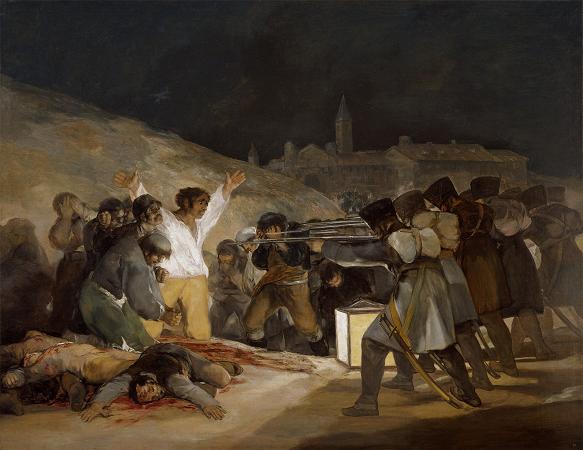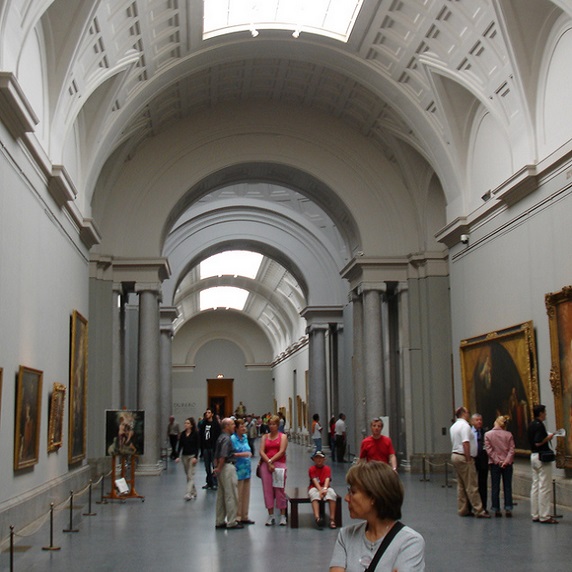Naked Maja (1800). Oil on canvas. 97 x 190. The Nude Maja is a name given to a c. 1797-1800 oil on canvas painting by the Spanish artist Francisco Goya. It portrays a nude woman reclining on a bed of pillows, and was probably commissioned by Manuel de Godoy, to hang in his private collection in a separate cabinet reserved for nude paintings. Goya created a pendant of the same woman identically posed, but clothed, known today as La maja vestida; also in the Prado, it is usually hung next to La maja desnuda. The subject is identified as a maja based on her costume in La maja vestida. The painting is renowned for the straightforward and unashamed gaze of the model towards the viewer. It has also been cited as among the earliest Western artwork to depict a nude woman's pubic hair without obvious negative connotations. With this work Goya not only upset the ecclesiastical authorities, but also titillated the public and extended the artistic horizon of the day. It has been in the Museo del Prado in Madrid since 1901. Although the two versions of the Maja are the same size, the sitter in the clothed version occupies a slightly larger proportion of the pictorial space; according to art historian Janis Tomlinson she seems almost to press boldly against the confines of her frame, making her more brazen in comparison to the comparatively timid nude portrait. The painting carries many of the traditions of depictions of the nude in Spanish art, but marks a clear break in significant ways, especially in her bold gaze. Further, the accompanying pendant showing a woman in contemporary dress makes it clear that the focus of the work is not of a mythological subject, as in Velazquez's Rokeby Venus, but in fact of a nude Spanish woman. More obviously, while Velazquez painted his Venus revealing only her back, Goya's portrait is a full frontal view. Goya's figuration is short and angular, while Velazquez's is elongated and curved, and his figure placed on richly coloured satin, which starkly contrasts to the bare white cloths Goya's maja rests on. The identity of the model and why the paintings were created are unknown. Both paintings are first recorded in an inventory of unpopular and unsuccessful art by Prime Minister Manuel de Godoy, Duke of Alcudia in 1800, when they were hung in a private room reserved for nude paintings, alongside such works as Velazquez's Rokeby Venus. Godoy retained the picture for six years before it was discovered by investigators for the Spanish Inquisition in 1808, along with his other questionable pictures. Godoy and the curator of his collection, Don Francisco de Garivay, were brought before a tribunal and forced to reveal the artists behind the confiscated art works which were so indecent and prejudicial to the public good. The controversy was populist and driven by a political motive, following a mob gathering demanding Godoy's removal as Prime Minister. In the fallout, Goya was named and summoned on a charge of moral depravity. As Godoy had only been found in possession of the painting, Goya was asked to identify why he did them, and also at whose request, and what attention guided him. His answers do not survive, but we know that the Director of Confiscations noted that Goya had only followed and emulated Titian's Danae series and Velazquez's Rokeby Venus; two painters, and their works, very much admired by the court and church, including their nudes, and the Inquisition had not found anything objectionable in the Rokeby Venus. Goya escaped prosecution when the tribunal accepted that he was following in a tradition, and emulating a Velazquez painting which had been favoured by Philip IV of Spain. The earlier picture of Venus had been similarly kept out of view by that art-loving king in a private room, the room where His Majesty retires after eating. In fact, the Inquisition by 1808 was nearing the end of its influence, and while it could draw attention to dangerous forms of expression, be they books, plays, or paintings, it was usually unable to fully suppress them. La maja desnuda has always hung alongside, above, or before its companion. They were twice in the collection of the Royal Academy of Fine Arts of San Fernando, also in Madrid, being sequestered by the Inquisition between 1814 and 1836 before being returned. They have been in the Prado since 1901. It is not known if the two works were intended to be hung together. One early account gives the Clothed Maja placed in front of the current work; the pull of a cord revealed the nude version. Today they are hung side by side, although others have suggested that they were intended to be spaced apart, and seen in succession. It has been conjectured that the woman depicted was Godoy's young mistress Pepita Tudo.
more...




